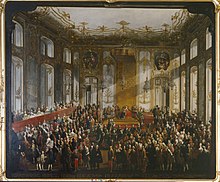This article includes a list of general references, but it lacks sufficient corresponding inline citations. (February 2015) |

The Austrian nobility (German: österreichischer Adel) is a status group that was officially abolished in 1919 after the fall of Austria-Hungary. Austria's system of nobility was very similar to that of Germany (see German nobility), as both countries were previously part of the Holy Roman Empire (962–1806).
Any noble living in the Habsburg-ruled lands, and who owed allegiance to the dynasty and therefore to the emperor, was also considered part of the Austrian aristocracy. This applied to any member of the Bohemian, Hungarian, Polish, Croatian, and other nobilities in the Habsburg dominions. Attempting to differentiate between ethnicities can be difficult, especially for nobles during the eras of the Holy Roman Empire and the Austro-Hungarian monarchy (1867–1918). A noble from Galicia, for instance, such as the Count Jordan-Rozwadowski (see section "Noble titles" below under Graf/Gräfin (count/countess)), could call himself a Polish noble, but he also rightfully belonged to the Austrian nobility.
Two categories among the Austrian nobility may be distinguished: the historic nobility that lived in the territories of the Habsburg Empire and who owed allegiance to the head of that dynasty until 1918, and the post-1918 descendants of Austrian nobility—specifically, those who retain Austrian citizenship, whose family originally come from Austria proper, South Tyrol, northern Italy and Burgenland, or who were ennobled at any point under Habsburg rule and identify themselves as belonging to that status group.[citation needed]